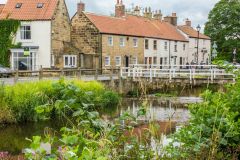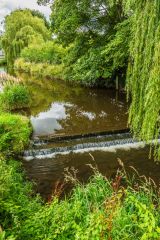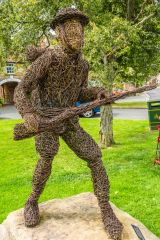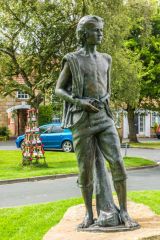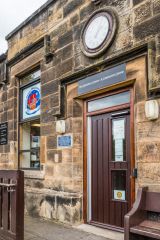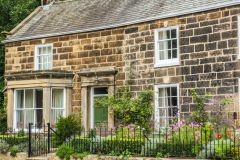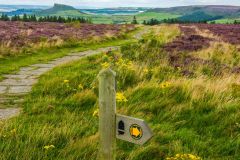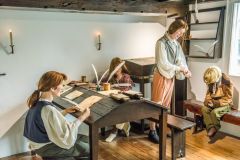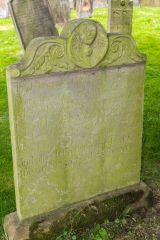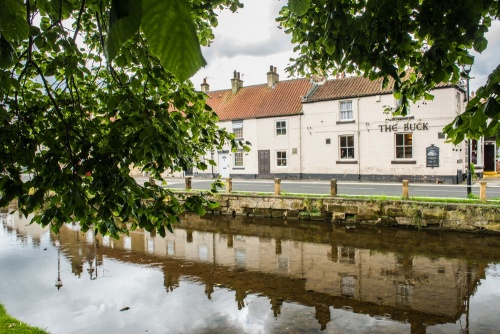
The picturesque village of Great Ayton stands on the banks of the slow-moving River Leven, just outside the north-western corner of the North York Moors National Park. The village grew up around two green linked by the river. High Green is in the centre of the village, and Low Green, to the west, is beside a river crossing.
The village name comes from the Old Norse term for a riverside settlement, or a farm by the river.
Great Ayton is famous for its links to the explorer and cartographer Captain Cook, who grew up here, and for its proximity to Roseberry Topping, a popular destination for walkers, particularly in the summer and early autumn when the moors are alive with lush purple heather.
Much of the village is a conservation area, protecting a large number of attractive heritage buildings and the timeless ambience of the village centre.
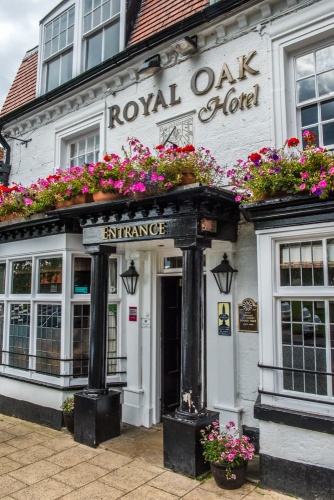
History
The area has been settled since Neolithic times, as evidenced by ancient finds within the parish. We know there was a settlement here in the Anglo-Saxon period, as evidenced by several carved fragments of early Christian crosses in the medieval church of All Saints.
Great Ayton was mentioned in the Domesday Book of 1086 when the lands here were divided into three manors. The king held one, another was held by Count Robert de Mortain and leased to a man named Nigel Fossard, and the third was owned by the Norman lord Robert Malet. The Fossard lands were the largest. Their estates passed through several hands over the centuries until they were acquired by the Nevilles, one of the most powerful families in northern England.
We know that there was a fulling mill on the River Leven in 1353 In later years Great Ayton developed several local industries including weaving, brewing, and tanning hides. It was also a centre for mining, with local quarries producing whinstone grit, alum, jet, and ironstone. A collapse of the alum and ironstone quarries helped create the unusual profile of Roseberry Topping, the iconic hill that towers over the village.
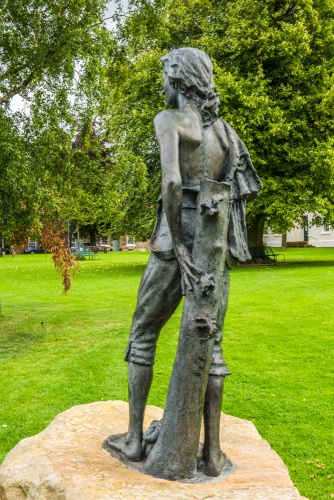
Captain Cook
In 1736 James Cook, a Scottish farm labourer, brought his wife Grace and their growing family to Great Ayton, where he found work at Aireyholme Farm. Mr Cook's employer was the lord of the manor, Thomas Skottowe. Cook's son James, Jr., then aged eight, began attending Postgate's School on the High Street, which entailed a round-trip walk of four miles each day.
The younger James Cook left school after four years, at the age of twelve. He helped his father at Aireyholme Farm for several years, but in 1744, at the age of sixteen, he left home and moved to the coastal village of Staithes where he was apprenticed to a shop keeper.
On High Green stands a statue of Captain Cook at the age of sixteen when he left home and went to Staithes. It was there that Cook first felt the lure of the sea and began to dream of a naval career. The statue, by Nicholas Dimbleby, shows young Cook looking in the direction of Staithes. The sculpture was commissioned by the Hambleton District Council and the Great Ayton Parish Council and was unveiled in 1997.
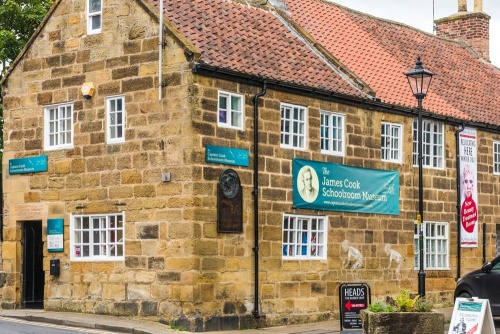
Captain Cook Schoolroom Museum
James Cook was eight years old when his family came to Great Ayton. With financial aid from his father's employer Thomas Skottowe, young James attended Postgate's school on High Street. The school was rebuilt in 1755 to make room for a poorhouse on the ground floor.
The building is now the Captain Cook Schoolroom Museum, covering James Cook's life and naval career, and the rich history of Great Ayton village. See a recreated schoolroom and the attic garret where the schoolmaster lived.
The museum has several objects closely linked to Captain Cook, including his wife's dinnerware and mourning ring, and Cook's horn cup, tobacco case, and portable inkwell. The museum is a great place to learn about Captain Cook and his life in Great Ayton.
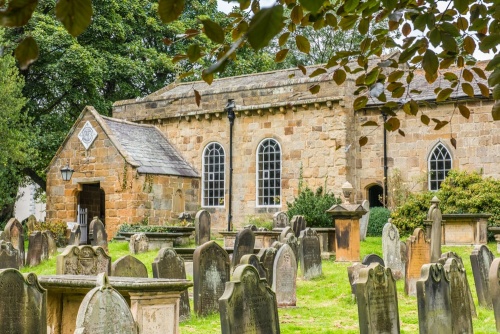
All Saints Church
Until 1876 the parish church of Great Ayton was All Saints, on Low Green, near the western end of High Street. The church dates to the 12th century but there was a much earlier Anglo-Saxon building on the same site, as evidenced by several carved cross-heads thought to date to the 8th century.
Captain Cook would have worshipped here as a child, and in the churchyard is a gravestone marking the final resting place of his mother Grace and five of his siblings (two sisters named Mary, his sister Jane, and his brothers William and John). The epitaph makes grim reading; two sisters died at five, another at 10 months, while William died at 12 months old. Only John lived to adulthood, but he died at 23.
The church interior has wonderful Georgian furnishings including a triple-decker pulpit and pews in the nave. On the north wall is a plaque commemorating Thomas Skottowe, the lord of the manor, who paid for James Cook's schooling.
Other historical features include a 12th-century south doorway and a font of the same age.
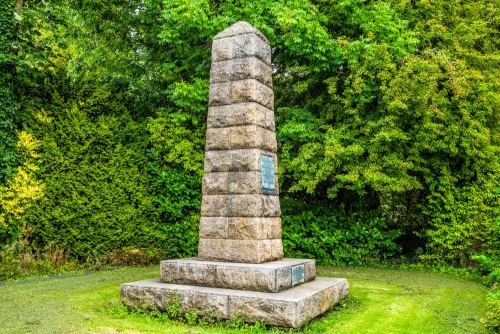
Captain Cook Memorial Garden
In 1755 James Cook, Sr. built a retirement home for himself and his wife Grace on Bridge Street in Great Ayton. James, Jr. had left home years before and was launching his naval career at roughly the same time. We don't know for certain that Captain Cook ever crossed the threshold of the new family home, but that didn't stop it being known in later years as 'Captain Cook's boyhood home'.
In 1934 the cottage was sold to a philanthropist named Russell Grimwade, who had the building disassembled, all the stones numbered and shipped to Australia where the house was reassembled in Fitzroy Park, Melbourne.
A granite obelisk stands on the site of the Cook family home, which now acts as a small memorial garden. The memorial is made from granite blocks quarried at Point Hicks, the first point of Australia sighted by Captain Cook. A similar monument also stands at Point Hicks.
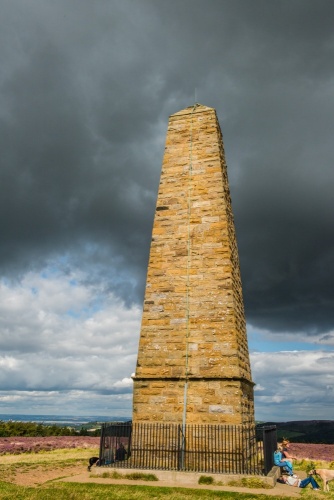
Captain Cook Monument
Do not confuse the memorial on the site of the Cook family home with the Captain Cook Monument on Easby Moor, overlooking the village. Just to be confusing, the Monument is also in the form of an obelisk, though in this case, it is 18m (60 feet) high. The Monument was erected in 1827 by Robert Campion, a wealthy banker from Whitby and owner of the Easby Manor estate.
It was struck by lightning in 1960 and split down the middle. It has been restored (this time with a lightning conductor for safety). You can reach the Captain Cook Monument by a footpath from the village, near the rail station, or by a short footpath from a parking area on Dikes Lane near Gribdale Terrace.
The Monument is directly on the Cleveland Way National Trail, which also runs by the foot of Roseberry Topping, to the north.
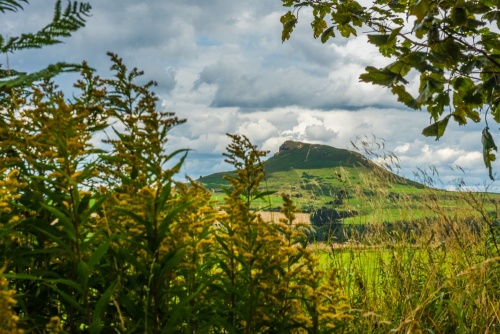
Roseberry Topping
Dubbed the 'Yorkshire Matterhorn', this oddly-shaped peak is one of the most popular destinations for walkers in Yorkshire. The hill is just outside the boundary of the North York Moors National Park.
From its summit you get wonderful views to the sea near Staithes, over the National park, west to the Yorkshire ales and north over Teesdale.
The hill's oddly-shaped summit is the result of a geological fault combined with a collapse of 20th-century mining works. There are two main routes up Roseberry Topping. One is from the car park on Dikes Lane, mentioned above (use TS9 6HQ for satnavs), and the other is from parking areas on the A173 just north of the village (use the postcode TS9 6QS).
Getting There
Great Ayton is at the junction of the A173 and B1292 about 5 miles south-west of Guisborough. There is usually parking along High Street, though from personal experience this can be crowded at certain times of the year. There is also parking at the rail station and High Green.
About Great Ayton
Address: A173,
Great Ayton,
Yorkshire,
England
Attraction Type: Village
Location: On the A173 about five miles south-west of Guisborough
Website: Great Ayton
Location map
OS: NZ558107
Photo Credit: David Ross and Britain Express
HERITAGE
 We've 'tagged' this attraction information to help you find related historic attractions and learn more about major time periods mentioned.
We've 'tagged' this attraction information to help you find related historic attractions and learn more about major time periods mentioned.
Find other attractions tagged with:
NEARBY HISTORIC ATTRACTIONS
Heritage Rated from 1- 5 (low to exceptional) on historic interest
Captain Cook Memorial - 0.1 miles (Historic Building) ![]()
Great Ayton, All Saints Church - 0.1 miles (Historic Church) ![]()
Captain Cook Schoolroom Museum - 0.2 miles (Museum) ![]()
Roseberry Topping - 1.5 miles (Countryside) ![]()
Captain Cook's Monument - 2 miles (Historic Building) ![]()
Ormesby Hall - 4.2 miles (Historic Building) ![]()
Captain Cook Birthplace Museum - 4.2 miles (Museum) ![]()
Cleveland Way National Trail - 4.5 miles (Countryside) ![]()
Nearest Holiday Cottages to Great Ayton:
Great Ayton, Yorkshire
Sleeps: 6
Stay from: £597 - 2218
More self catering near Great Ayton
